How to get rid of caterpillars on pepper
Bell pepper is one of the most delicious and healthy garden crops. However, the plant is attractive not only to humans, but also to insect pests.
Often on the leaves of pepper you can see nondescript small caterpillars that devour the leaves, impairing photosynthesis and plant nutrition. A massive invasion of these insects will lead to crop loss.
The article will tell you what to do if an annoying pest appears, and how to deal with caterpillars on peppers in a greenhouse and open field.
The content of the article
Why do caterpillars appear on pepper
Pepper caterpillars can appear for several reasons.
Caterpillars initially settle on grasses and weeds.... When there is a lack of food, they begin to crawl to neighboring areas, easily overcoming considerable distances. If the summer is wet with prolonged rains, then this environment will be the most nutritious for their intensive reproduction.
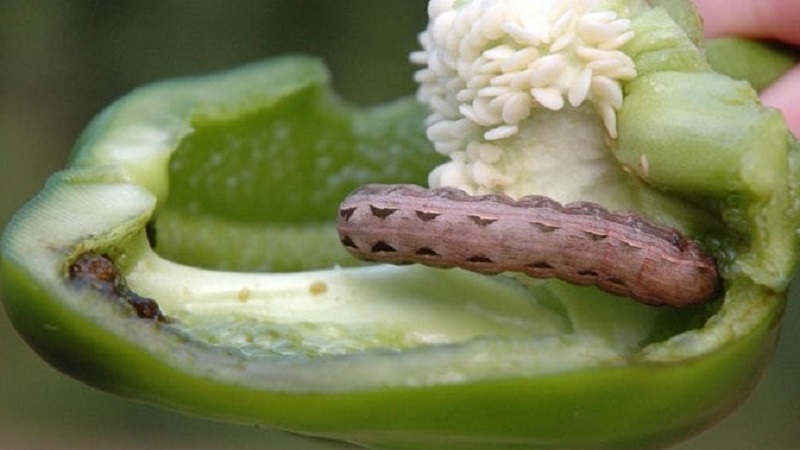
Pest eggs can be found on pepper seedlingsthat you purchase.
Caterpillars can winter outdoors... When such a substrate enters the greenhouses, the chance of caterpillars on the seedlings is very high. In greenhouses, caterpillars appear much more often than in open ground. This is due to the more humid environment and the lack of direct sun in the greenhouse. In drought and sunlight, pest eggs die.
Other pests on peppers:
Fast and effective pest control - pepper slugs
Aphids appeared on pepper in a greenhouse: how to defeat a pest
Varieties of caterpillars
The name of small green caterpillars, the most vicious pests of pepper - scoop... There are about 100 species of this insect. The adult scoop looks inconspicuous: a small butterfly with dark brown wings covered with gray and orange spots, and a light gray line along the edges.
The caterpillar of the scoop is green, on its back there are transverse lines, and a light green stripe runs along the sides. It is not easy to spot the scoop among the plants. During the day, the pest hides and appears only in the evening.
Mainly 2 types of caterpillars live in the gardensthat eat bell peppers: winter scoop and gamma scoop.
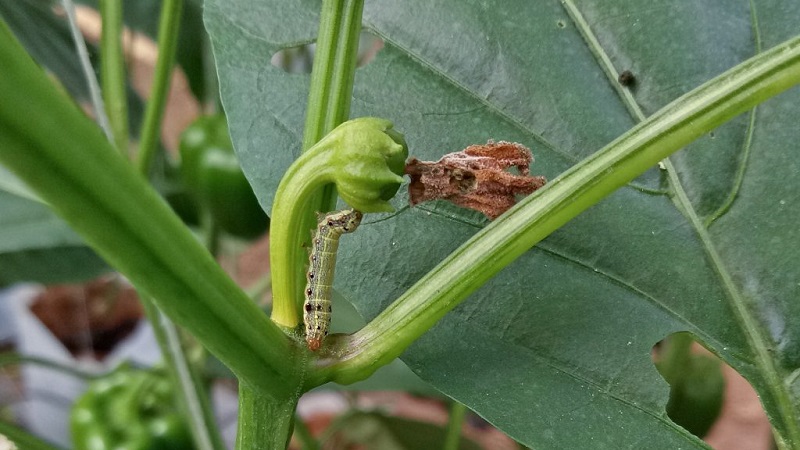
Winter scoop
A pest caterpillar survives the winter in an egg shell... She leaves it only in spring at a stable temperature of + 8 ... + 10 ° С. The hatched caterpillar first devours weeds, and then switches to garden crops.
Most of all, the winter scoop loves peppers and tomatoes.... She is able to completely destroy the plant, gnawing the roots and stem at the very soil. She lives on a plant for only a few days, then begins to hide in the ground. The color of the caterpillar is gray-greenish with longitudinal dark stripes on the sides. The body length of the pest reaches 5-6 cm.
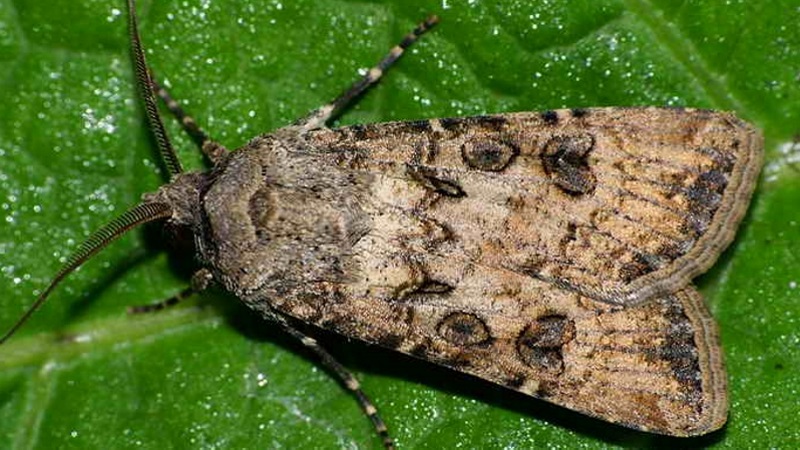
Gamma scoop
Refers to leaf-eating pests... The Gamma-scoop lives mainly on plant stems. Like the winter moth, it first feeds on weeds, and then migrates to garden crops.
The pest eats the fleshy parts of the pepper leaf and gnaws the pulp of the fruit... Often the scoop feeds on unripe fruits, unopened buds, and eats the plant in just a few hours, after which it moves to another. The color of the gamma scoop is light green with small specks or green. The body of the caterpillar is thick, 4 cm long.
Signs of the appearance of caterpillars
Having information about the signs and timing of the appearance of scoops on peppers and measures to combat it, you can prevent the invasion of the pest, save and grow the crop.
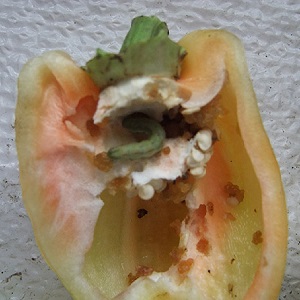 The moths appear for the first time in April-May, and in summer they can be seen from late July to late September... If during this time you notice small brown butterflies in the evening, keep a close eye on the peppers. Butterflies are the first signal.
The moths appear for the first time in April-May, and in summer they can be seen from late July to late September... If during this time you notice small brown butterflies in the evening, keep a close eye on the peppers. Butterflies are the first signal.
That caterpillars appeared in the seedlings, small holes on the leaves or their eaten edges will prompt.
If the pepper has already formed flowers, began to gain strength and suddenly began to fall off, then with a high probability caterpillars wound up in them.
Rapid wilting of plants also speaks of a pest invasion. When these signs appear, it is better to take action immediately, since the scoops are very gluttonous.
Reference! One caterpillar can destroy up to 10 plants per night.
Control methods
Getting rid of the scoop infestation is not easy. You can fight the pest in different ways, from the most radical to the gentle... You will achieve results faster if you start to remove caterpillars with chemical or biological preparations. But when the priority is environmental friendliness and cleanliness of the crop, folk remedies are more suitable.
Chemical methods
Chemicals (insecticides) in different ways affect pests:
- destroy eggs and larvae;
- scare away insects;
- paralyze the respiratory and nervous systems;
- inhibit sexual function.
Important! Insecticides have 1-4 toxicity classes, therefore, when using them, personal protective equipment is required. It is not recommended to work with insecticides for more than 1 hour.
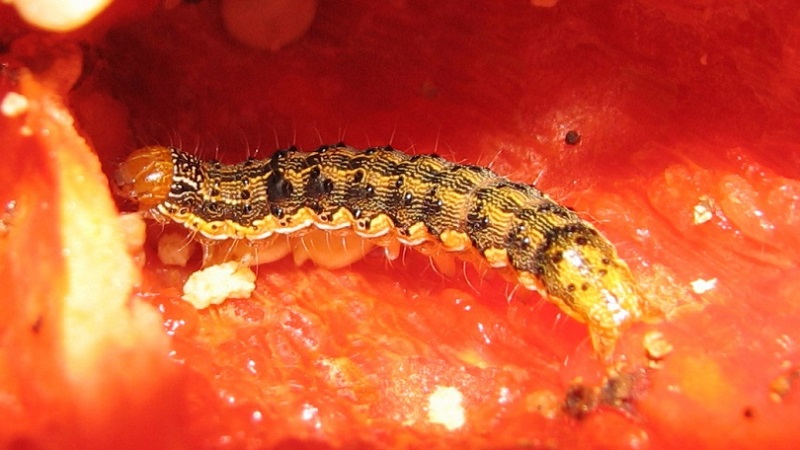
Against the scoop the most effective have proven themselves: "Bazudin", "Stefesin", "Zolon", "Fury", "Decis-Profi".
Peppers can be treated with insecticides 1-2 times per season, given that each drug has its own waiting period of 20 days or more, depending on the toxicity class.
Read also:
Biological methods
Biologicals do not contain insecticides and differ from chemical in a number of advantages:
- the possibility of processing plants without restrictions and throughout the growing season;
- lack of waiting periods;
- stimulation of plant defenses and soil health;
- lack of toxic substances.
The result of using biological products occurs within a week... Insects remain on the leaves, but lose their mobility and stop feeding. They no longer harm plants and die completely after a week.
The most common biological products: "Fitoverm", "Entobacterin", "Bitoxibacillin", "Dendrobacillin", "Natur Guard".
Folk methods
How to get rid of caterpillars with folk remedies?
Insofar as caterpillars do not tolerate tobacco, the use of tobacco tincture will be effective. Tobacco dust or makhorka is mixed with water in a ratio of 1:10 and infused for 3 days.
Can sprinkle the peppers with infusion of onion peels: 200 g of husk insist 3-4 days in 10 liters of water.
Another problem for caterpillars is garlic tincture... It is prepared in the same way as onion: 200 g of garlic cloves per 10 liters of water. The tincture is ready in a day.
A decoction of yarrow helps well. Steam 800 g of dry mass in boiling water for 40 minutes and bring with water to a volume of 10 liters.
The better to process peppers from caterpillars, it is up to the gardener to decide - with strict adherence to the recipe, any remedy will bring results.
An effective way to prevent infection - scare away or destroy scoop butterflies. Traps are prepared for them from a fermented sweet drink: kvass, juice, compote, jam.
Reference! If you want to stop the pest in time, install pheromone baits on the site. This is a surefire way to prevent it from multiplying.

Prevention measures
It is much easier to prevent the appearance of scoop caterpillars on pepper than to destroy them later.... Prevention measures are simple and do not take long.
The greenhouse in the fall after harvest and in the spring before sowing must be treated with disinfectants. A similar procedure is carried out with the inventory.
In the fall, in order to destroy the caterpillars buried in the ground for wintering, the soil is dug deeply, and the grooves are filled with slaked lime. In the spring, the soil is also dug deeply, approximately 26-28 cm.
Butterflies enter greenhouses through slots and open windows... To prevent this, special nets are hung on the windows from the inside. It is necessary to loosen the soil more often, remove weeds in a timely manner. Mulching the beds with sawdust or grass helps.
Attention! The insecticide treatment is carried out before the flowering period.
Conclusion
You can deal with pepper pests in different ways, but despite many measures, this culture is one of their favorite treats for them. Therefore, the main condition for obtaining a good harvest of peppers will be timely identification and destruction of caterpillars, as well as preventive measures - disinfection of soil and greenhouse structures.